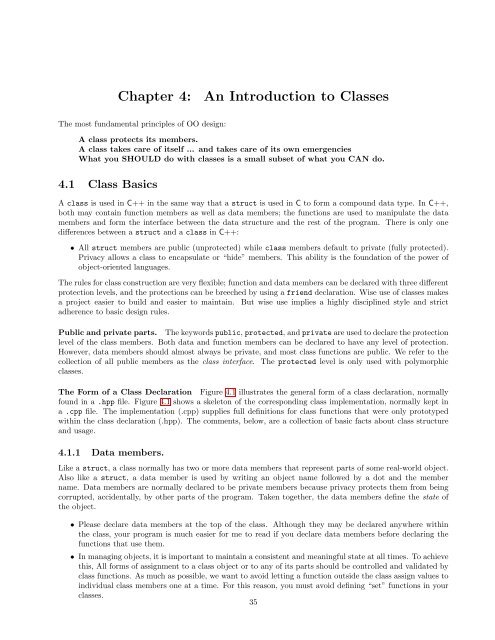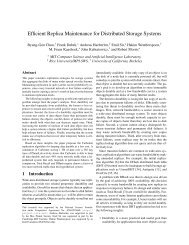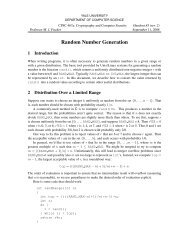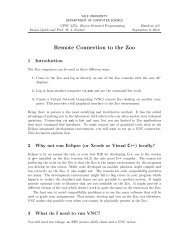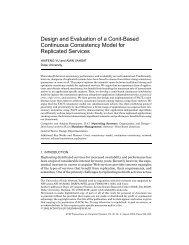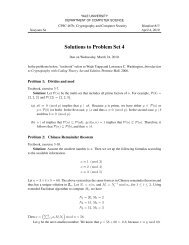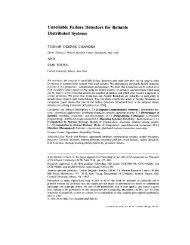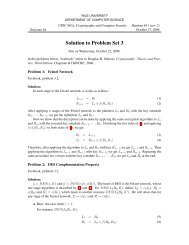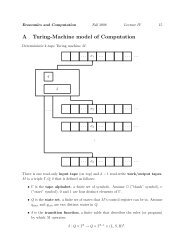Chapter 4: An Introduction to Classes - Zoo
Chapter 4: An Introduction to Classes - Zoo
Chapter 4: An Introduction to Classes - Zoo
You also want an ePaper? Increase the reach of your titles
YUMPU automatically turns print PDFs into web optimized ePapers that Google loves.
38 CHAPTER 4. AN INTRODUCTION TO CLASSESPoint p1(1, 0);Point * pp = new Point(0, 1);p1.plot( );pp->plot();// Allocate and initialize a point on the stack.// Dynamically create an initialized point.In both cases, the declared type of p1 or p2 supplies context for the function call, so we know we are calling theplot function in the Point class.Calls on non-class functions are exactly the same in C and in C++. Compare lines 17 (C) and 1011 (C++)in the code examples at the end of this chapter.Typical Function Members Almost every class should have at least three public member functions: aconstruc<strong>to</strong>r, a destruc<strong>to</strong>r, and a print function.• A construc<strong>to</strong>r function initializes a newly created class object. More than one construc<strong>to</strong>r can be definedfor a class as long as each has a different signature 4 . The name of the construc<strong>to</strong>r is the same as the nameof the class.• A destruc<strong>to</strong>r function is used <strong>to</strong> the free s<strong>to</strong>rage occupied by a class object when that object dies. <strong>An</strong>yparts of the object that were dynamically allocated must be explicitly freed. If an object is created bya declaration, its destruc<strong>to</strong>r is au<strong>to</strong>matically called when the object goes out of scope. In an object iscreated by new, the destruc<strong>to</strong>r must be invoked explicitly by calling delete. The name of the destruc<strong>to</strong>ris a tilde followed by the name of the class.• A print() function defines the class object’s image, that is, how should look on the screen or on paper.This function normally has a stream parameter so that the image can be sent <strong>to</strong> the screen, a file, etc.Call this function simply “print()”, with no word added <strong>to</strong> say the type of the thing it is printing, anddefine a method in every class you write. Format your class object so that it will be readable and lookgood in lists of objects.4.2 Inline FunctionsInline and out-of-line function translation. C++ permits the programmer <strong>to</strong> choose whether each functionwill be compiled out-of-line (the normal way) or inline. <strong>An</strong> out-of-line function is compiled once perapplication. No matter how many times the function is called, its code exists only once.When a call on an out-of-line function is translated, the compiler generates code <strong>to</strong> build a stack frame,copy the function arguments in<strong>to</strong> it, then jump <strong>to</strong> the the function. At load time, the linker connects the jumpinstruction <strong>to</strong> the actual memory location where the single copy of the function code exists.At run time, when the function call is executed, a stack frame is built, the argument values are copied in<strong>to</strong>it, and control is transferred from the caller <strong>to</strong> the function code. After the last line of the function, control anda return value are passed back <strong>to</strong> the caller and the function’s stack frame is deallocated (popped off the systemrun-time stack). This process is done efficiently but still takes non-zero time, memory space for parameters<strong>to</strong>rage, and space for the code that performs the calling sequence.Inline functions are not macros. Inline expansion is like macro expansion. However, an inline function ismore than and less than a macro, and is used differently:• The number of arguments in both a function call and a macro call must match the number of parametersdeclared in the function or macro definition. The types of the arguments in the function call must match(or be convertible <strong>to</strong>) the parameter types in the definition. However, this is not true of macros, whereparameter types are not declared and arguments are text strings, not typed objects.• Macros are expanded during the very first stage of translation, and the expansion process is like the searchand-replaceprocess in a text edi<strong>to</strong>r. Because of this, a macro can be defined and used as a shorthandnotation for any kind of frequently-used text string, even one with unbalanced parentheses or quotes.Functions cannot be used this way. Functions are compiled at a later stage of translation.4 The signature of a function is a list of the types of its parameters.
4.2. INLINE FUNCTIONS 39When a call on an inline function is compiled, the entire body of the function is copied in<strong>to</strong> the objectcode of the caller, like a macro, with the argument values replacing references <strong>to</strong> the parameters. If the samefunction is called many times, many copies of its code will be made. For a one-line function, the compiled codeis probably shorter than the code required <strong>to</strong> implement an ordinary function call. Short functions should beinline because it always saves time and can even save space if there are only a few machine instructions in thefunction’s definition. However, if the function is not short and it is called more than once, inline expansion willlead <strong>to</strong> a longer object file.Usage. The main reason for using inline definitions is efficiency. Inline expansion of a very short function willsave both time and space at run time.The main reason for using out-of-line definitions is readability. It is helpful <strong>to</strong> be able <strong>to</strong> see an entire classdeclaration at once. If a class has some long functions, we put them in a separate file so that the rest of theclass will fit on one page or one computer screen. For this reason, any function that is longer than two or threelines is generally given only a pro<strong>to</strong>type within the class declaration. In contrast, when a function is only oneor two lines long, it is easier <strong>to</strong> read when it is inside the class definition; there is no advantage in breaking itin<strong>to</strong> two parts.The inline keyword. A function defined fully within the class declaration is au<strong>to</strong>matically inline. In addition,a function pro<strong>to</strong>type can be declared <strong>to</strong> be inline even if it is defined remotely. To do this, simply write thequalifier inline before the return type in the function definition. This qualifier is advice <strong>to</strong> the compiler, not arequirement. A compiler may ignore the inline qualifier if it judges that a function is <strong>to</strong>o long or <strong>to</strong>o complex<strong>to</strong> be inline.Summary of inline rules and concepts.• <strong>An</strong> inline function is expanded like a macro, in place of the function call. No stack frame is built andthere is not jump-<strong>to</strong>-subroutine.• Functions defined in a class (between the class name and the closing bracket) default <strong>to</strong> inline.• Non-class functions and class functions defined after the class may be compiled as inline functions if thekeyword “inline” is written before the function return type of the pro<strong>to</strong>type within the class.• The compiler treats “inline” as advice, not as orders; if a particular compiler thinks it is inappropriate ina particular situation, the code will be compile out-of-line anyway.• In order <strong>to</strong> compile, the full definition of an inline function must be available <strong>to</strong> the compiler when everycall <strong>to</strong> the function is compiled.• Make extensions of opera<strong>to</strong>r > inline or put them in the .cpp file of the related class.4.2.1 Code Files and Header FilesUsing .cpp and .hpp files The purpose of a header file is <strong>to</strong> provide information about the class interfacefor inclusion by other modules that use the class. The .hpp file, therefore contains the class declaration andrelated #include, #define, and typdef statements. Executable code, other than definitions of inline functions,does not belong in a .hpp file.In-class and remote definitions. A class function can be fully defined within the class declaration or justpro<strong>to</strong>typed there and defined later. Although there are no common words for these placement options, I callthem in-class and remote. Being in-class or remote has no connection <strong>to</strong> privacy: both public and privatefunctions can be defined both ways.Remote inline functions cause an organization problem. In order for inline expansion <strong>to</strong> be possible, theactual definition of an inline function must be available <strong>to</strong> the compiler whenever the function is called. Theonly reasonable way <strong>to</strong> do this is <strong>to</strong> put the full definition of each inline function in the .hpp file, after the endof the class declaration, along with related inline non-class functions, such as extensions of the input and outpu<strong>to</strong>pera<strong>to</strong>rs. Then, wherever the class is visible <strong>to</strong> the compiler, the related inline definition will also be visible.
40 CHAPTER 4. AN INTRODUCTION TO CLASSESThe definitions of non-inline remote class functions, if any, are written in a .cpp file. Each .cpp file will becompiled separately and later linked with other modules and with the library functions <strong>to</strong> form an executableprogram. This job is done by the system linker, usually called from your IDE. Non-inline functions that arerelated <strong>to</strong> a class, but not part of it, can also be placed in its .cpp file.Friends. Friend classes will be explained soon; they are used <strong>to</strong> build data structures (such as linked lists)that require two or more mutually-dependant class declarations. Friend functions are legal but not really useful;I discourage their use. Friend declarations are written within the class declaration in the .hpp file, either at thevery <strong>to</strong>p or the very bot<strong>to</strong>m of the class.4.3 Declaration, Implementation, and Application of a Stack ClassIn this section, we compare C and C++ implementations of a program <strong>to</strong> analyze a text file and determinewhether its bracketing symbols are correctly nested and balanced. A stack class is used <strong>to</strong> check the nesting.Two application classes are also defined, Token (<strong>to</strong> represent one opening bracket) and Brackets (the boss classof the application). For each part of the program, the C version is presented first (with line numbers starting at1), followed by the C++ version (with line numbers starting at 1000). The program notes compare the versions.4.3.1 The Input and Output (banners have been deleted).Each set of output on the right was produced by both versions of the Brackets program after processing theinput on the left. This program ends when the first bracketing error is discovered.Contents of input file: Output produced:(){}[[]] Welcome <strong>to</strong> the bracket checker!Checking file ’text2’The brackets in this file are properly nested and matched.Normal termination.(){}[[ Welcome <strong>to</strong> the bracket checker!Checking file ’text4’Created stack bracketsMismatch at end of file: Too many left bracketsThe stack brackets contains: Bot<strong>to</strong>m [ [ TopError exit; press ’.’ and ’Enter’ <strong>to</strong> continue(< This is some text Welcome <strong>to</strong> the bracket checker!>) Checking file ’text5’Some more text >) The stack ’bracket stack’ contains: Bot<strong>to</strong>m [ Top{}The current mismatching bracket is ’)’Incorrect file name Welcome <strong>to</strong> the bracket checker!Checking file ’text’can’t open file ’text’ for readingNo file name supplied.Press ’.’ and ’Enter’ <strong>to</strong> continueWelcome <strong>to</strong> the bracket checker!usage: brackets filePress ’.’and ’Enter’ <strong>to</strong> continue
42 CHAPTER 4. AN INTRODUCTION TO CLASSES6667 //-----------------------------------------------------------------------------68 void mismatch(string msg, int lineno, Stack* stkp, Token* <strong>to</strong>kp )69 {70 if (<strong>to</strong>kp == NULL) printf("Mismatch at end of file: %s\n", msg);71 else printf("Mismatch on line %d: %s\n", lineno, msg);7273 print( stkp ); printf( "\n\n" ); // print stack contents74 if (<strong>to</strong>kp != NULL) // print current <strong>to</strong>ken, if any75 printf("The current mismatching bracket is ’%c’\n\n", <strong>to</strong>kp->ch );7677 exit(1); // abort further processing78 }Notes on both versions of the main program:• Every program must have a function named main. Unlike Java, main() is not inside a class. Like C, theproper pro<strong>to</strong>type of main is one of these two lines. (Copy exactly, please. Do not use anything else.)int main( void );int main( int argc, char* argv[] );• Although both versions were written on the same day by the same people, the C++ version is moremodular: main.c contains the functionality of both main.cpp and brackets.cpp. Thus, the include files,pro<strong>to</strong>types, and constant definitions for the two purposes are mushed <strong>to</strong>gether in main.c.• The C++ version separates the actions of main (deal with the command-line arguments, initialize andstart up the application) from the actions of the application itself (read a file and analyze the bracketswithin it). This is a cleaner design.• The functions banner, say, fatal(), and bye are defined in the <strong>to</strong>ols library. Note that some of thesefunctions use C-style formats, and that the output produced that way mixes freely with C++-style output.• Both versions call banner and print a greeting comment. This is the minimum that a program should dofor its human user. (Lines 15–16 and 1010–1011)• Both versions test for a legal number of command-line arguments and provide user feedback whether ornot the number is correct. (Lines 18–19 and 1013–1014) Note the form of the usage error comment andimitate it when you are using command-line arguments.• Both versions use the command-line argument <strong>to</strong> open and input file and check for success of the openingprocess. (Lines 21–22 and 1016–1017)1000 //==============================================================================1001 // Project: Bracket-matching example of stack usage File: main.cpp1002 // Author: Michael and Alice Fischer Copyright: January 20091003 // =============================================================================1004 #include "<strong>to</strong>ols.hpp"1005 #include "brackets.hpp"10061007 //-----------------------------------------------------------------------------1008 int main(int argc, char* argv[])1009 {1010 banner();1011 say("Welcome <strong>to</strong> the bracket checker!");10121013 if (argc!=2) fatal("usage: %s file", argv[0]);1014 say("Checking file ’%s’", argv[1]);10151016 ifstream in( argv[1] );1017 if (! in ) fatal("can’t open file ’%s’ for reading", argv[1]);10181019 Brackets b; // Declare and initialize the application class.1020 b.analyze( in ); // Execute the primary application function.1021 in.close();1022 bye();1023 }
4.3. DECLARATION, IMPLEMENTATION, AND APPLICATION OF A STACK CLASS 43• Line 24 calls the primary application function and supplies the open input stream as an argument. Line1019 calls new <strong>to</strong> create and initialize an object of the Brackets class. Line 1020 calls the primaryapplication function with the stream as an argument. The C++ brackets-object, b, was allocated bydeclaration instead of by calling new, so it will be deallocated au<strong>to</strong>matically when control leaves thefunction on line 1023. We can do the same job by calling new, as in Java, like this:Brackets* b = new Brackets();b->analyze( in );delete b;// Create and initialize the application class.// If you create with new, you must later call delete.• The last two lines close the input file and print a termination message. (Lines 25–26 and 1021–22)• Note that, at this point, the C++ program is five lines shorter than the C program that does the samething in the same way with the same code formatting.4.3.3 The Brackets class.The C++ implementation has a class named Brackets that corresponds <strong>to</strong> the two functions at the end ofmain.c. The code in Brackets.cpp is like the two functions at the end of main.c, and the code in Brackets.hppis largely extra. At this point, the C++ version is 21 lines longer than the C version. So why make a Bracketsclass?1. It is better design. The functionality of handling command line arguments and files is completely separatedfrom the work of analyzing a text. Similarly, the central data parts of the class are separated from localtemporary variables.2. Each class gives you a construc<strong>to</strong>r function, where all the initializations can be written, and a destruc<strong>to</strong>rfunction for writing calls on delete. You are unlikely <strong>to</strong> forget <strong>to</strong> initialize or free your s<strong>to</strong>rage.1024 // ============================================================================1025 // Name: Bracket-matching example of stack usage File: brackets.hpp1026 // ============================================================================1027 #ifndef BRACKETS_H1028 #define BRACKETS_H10291030 #include "<strong>to</strong>ols.hpp"1031 #include "<strong>to</strong>ken.hpp"1032 #include "stack.hpp"10331034 class Brackets {1035 private:1036 Stack* stk;1037 Token <strong>to</strong>p<strong>to</strong>k;1038 int lineno;10391040 public:1041 Brackets() {1042 stk = new Stack( "brackets" );1043 lineno = 1;1044 }1045 ~Brackets(){ delete stk; }10461047 void analyze( istream& in); // Check bracket nesting and matching in file.1048 void mismatch( cstring msg, Token <strong>to</strong>k, bool eofile ); // Handle errors.1049 };1050 #endifNotes on the Brackets header file.the page.File headers have been shortened from here on, <strong>to</strong> conserve space on• The first two lines of each header file and the last line (1027, 1028, and 1050), are conditional compilationcommands. Their purpose is <strong>to</strong> ensure that no header file gets included twice in any compilation step.Note the keywords and the symbol and copy it.
44 CHAPTER 4. AN INTRODUCTION TO CLASSES• Next come the #include commands (Lines 1030–32) for classes and libraries that will be needed byfunctions defined in this class. Put them here, not in the .cpp file. Note: the file <strong>to</strong>ols.hpp includes allthe necessary standard header files.• The destruc<strong>to</strong>r (Line 1045) is responsible for freeing all dynamic memory allocated by the construc<strong>to</strong>rand/or by other class functions.• The construc<strong>to</strong>r (Lines 1041–1044) allocates the necessary dynamic space and initializes the two relevantdata members. The third data member, <strong>to</strong>p<strong>to</strong>k, will be used later as a way for the —pg analyze() function<strong>to</strong> communicate with the mismatch() function.• This construc<strong>to</strong>r and destruc<strong>to</strong>r are both short, so they are defined inline. The other two functions arelong and contain control structures, so they are declared here (Lines 1047–48) and defined in the .cpp file.Notes on Brackets.cpp and the corresponding C functions.• The .cpp file for a class should #include the corresponding header file and nothing else.• Please note the line of dashes before each function. This is a huge visual aide. Do it. Good style alsodictates that you add comments <strong>to</strong> explain the purpose of the function. I omit that <strong>to</strong> conserve space onthe page, and because these notes are provided.• Note that the return type of functions in the .cpp file are written, with the class name, on the line abovethe function name. As the term goes on, return types and class names will get more and more complex.Writing the function name at the left margin improves program readability.• The definitions of analyze and mismatch belong <strong>to</strong> the Brackets class, but they are not inside the class(between the word class and the closing curly brace). Unlike Java, a C++ compiler does not look at yourfile names, and has no way <strong>to</strong> know that these functions belong <strong>to</strong> your Brackets class. Therefore, the fullname of each function (i.e. Brackets::analyze) must be given in the .cpp file.• The argument <strong>to</strong> the analyze function (Line 1057) is a reference <strong>to</strong> an open stream. Streams are alwayspassed by reference in C++.• The C program has a call on init (Line 38) that is not needed in C++ because class construc<strong>to</strong>r functionsare called au<strong>to</strong>matically when an object is declared.• <strong>An</strong> infinite for loop with an if..break is used here <strong>to</strong> process the input file because it is the simplestcontrol form for this purpose. It is not valid <strong>to</strong> test for end of file until after the input statement, so younormally do not want <strong>to</strong> start an input loop by writing: while (!in.eof()) ...• We use the get function (line 1062) <strong>to</strong> read the input. This is a generic function; what gets read isdetermined by the type of its argument. In this case, ch is a char, so the next keystroke in the file willbe read and s<strong>to</strong>red in ch (get() does not skip whitespace).• We count the newlines (Lines 43, 1064) so that we can give intelligent error comments.• Line 1065 declares a local temporary variable named cur<strong>to</strong>k and calls the Token construc<strong>to</strong>r with theinput character <strong>to</strong> initialize it. This object is created on the stack inside the for loop. It will be deletedwhen control reaches the end of the loop on line 1082. Every time we go around this loop, a new Tokenis created, initialized, used, and discarded. This is efficient, convenient and provides maximal locality.• We create Tokens so that we can s<strong>to</strong>re the input along with its two classifications: the side (left or right)and the type of bracket (paren, angle, brace, square). The task of figuring out the proper classificationis delegated <strong>to</strong> the Token class because the Token class is the expert on everything having <strong>to</strong> do withTokens.• In the C version, we do not have the au<strong>to</strong>matic initialization action of a class construc<strong>to</strong>r, so we have <strong>to</strong>call the classify function explicitly. (Line 44)• When we get <strong>to</strong> line 45 or 1066, the <strong>to</strong>ken has been classified and we can tell whether it is of interest(brackets) or not (most characters). If it is of no interest, we continue at the bot<strong>to</strong>m of the loop (line1082), deallocate the Token, and repeat.• The switch (Lines 46–59 and 1068..1081) stacks opening brackets for later matching, and attempts <strong>to</strong>match closing brackets. The second case is complex because it must test for two error conditions.
4.3. DECLARATION, IMPLEMENTATION, AND APPLICATION OF A STACK CLASS 45• Line 48 pushes the new Token on<strong>to</strong> the stack stk (declared on line 35). Note that we write stk insidethe parentheses here, and before the parentheses in the C++ version. We use call-by-address here becausethe function will modify the stack. Line 1070 pushes the new Token on<strong>to</strong> the stack named stk which is amember of the Brackets class. We could write this line as: this->stk->push(cur<strong>to</strong>k);, which is longerand has exactly the same meaning.• Lines 62–63 and 1083–86 handle normal termination and another error condition. To keep the analyzefunction as short as possible, most of the work of error handling is fac<strong>to</strong>red out in<strong>to</strong> the mismatch function.It prints a comment, the current <strong>to</strong>ken (if any) and the stack contents.• Because there is no destruc<strong>to</strong>r function, the C version must free dynamic s<strong>to</strong>rage explicitly (Line 64).1051 // ============================================================================1052 // Name: Bracket-matching example of stack usage File: brackets.cpp1053 // ============================================================================1054 #include "brackets.hpp"1055 //-----------------------------------------------------------------------------1056 void Brackets::1057 analyze( istream& in)1058 {1059 char ch;10601061 for (;;) { // Read and process the file.1062 in.get(ch); // This does not skip leading whitespace.1063 if ( in.eof() ) break;1064 if (ch == ’\n’) lineno ++;1065 Token cur<strong>to</strong>k( ch );1066 if (cur<strong>to</strong>k.getType() == BKT_NONE) continue; // skip non-bracket characters10671068 switch (cur<strong>to</strong>k.getSense()) {1069 case SENSE_LEFT:1070 stk->push(cur<strong>to</strong>k);1071 break;10721073 case SENSE_RIGHT:1074 if (stk->empty())1075 mismatch("Too many right brackets", cur<strong>to</strong>k, false);1076 <strong>to</strong>p<strong>to</strong>k = stk->peek();1077 if (<strong>to</strong>p<strong>to</strong>k.getType() != cur<strong>to</strong>k.getType())1078 mismatch("Closing bracket has wrong type", cur<strong>to</strong>k, false);1079 stk->pop();1080 break;1081 }1082 }1083 if ( stk->empty())1084 cout
46 CHAPTER 4. AN INTRODUCTION TO CLASSES4.3.4 Class Declaration: <strong>to</strong>ken.h and <strong>to</strong>ken.hpp79 // =============================================================================80 // Project: Bracket-matching example of stack usage File: <strong>to</strong>ken.h81 // =============================================================================82 #ifndef TOKEN_H83 #define TOKEN_H8485 #include "<strong>to</strong>ols.h"8687 typedef enum {BKT_SQ, BKT_RND, BKT_CURLY, BKT_ANGLE, BKT_NONE} Bracket_type;88 typedef enum {SENSE_LEFT, SENSE_RIGHT} Token_sense;8990 typedef struct {91 Bracket_type typ;92 Token_sense sense;93 char ch;94 } Token;9596 Token classify( char ch );97 #endif // TOKEN_H1102 // ============================================================================1103 // Project: Bracket-matching example of stack usage File: <strong>to</strong>ken.hpp1104 // ============================================================================1105 #ifndef TOKEN_HPP1106 #define TOKEN_HPP11071108 #include "<strong>to</strong>ols.hpp"11091110 enum BracketType {BKT_SQ, BKT_RND, BKT_CURLY, BKT_ANGLE, BKT_NONE};1111 enum TokenSense {SENSE_LEFT, SENSE_RIGHT};11121113 class Token {1114 private:1115 BracketType type;1116 TokenSense sense;1117 char ch;1118 void classify( char ch );11191120 public:1121 Token( char ch );1122 Token(){}1123 ~Token(){}1124 ostream& print( ostream& out) { return out
4.3. DECLARATION, IMPLEMENTATION, AND APPLICATION OF A STACK CLASS 47• The classify function is public in C and private in C++ because, in OO languages, it is possible <strong>to</strong>encapsulate class members that are not useful <strong>to</strong> client classes. (Definition of encapsulate: separate theinterface from everything else in the class, and keep everything else private.)• The C classify function returns a Token value but the C++ version does not. The C++ version does itswork by s<strong>to</strong>ring information in the data members of the current object. When called by the construc<strong>to</strong>r,classify will initialize part of the Token under construction.• The C++ class has six functions that are not present in the C version. There are two construc<strong>to</strong>rs:the normal one (line 1121) and a do-nothing default construc<strong>to</strong>r (line 1122) that allows us <strong>to</strong> createuninitialized Token variables. Such a variables become useful when they receive assignments.• The destruc<strong>to</strong>r (line 1123) is a do-nothing function because this class does not ever allocate dynamicmemory. It is good style, but not necessary, <strong>to</strong> write this line of code. If omitted, the compiler will supplyit au<strong>to</strong>matically.• The other three functions (lines 1124–1126) that have no C analog are accessor functions, sometimes called“get functions”. Although it is traditional <strong>to</strong> use the word “get” as the first part of the name, that isnot necessary. The entire purpose of a get function is <strong>to</strong> provide read-only access <strong>to</strong> a private class datamember.• Associated with the Token class, but not part of it, is an extension of opera<strong>to</strong>r if you gave the parameter a different name.• A class takes care of itself. The construc<strong>to</strong>r’s responsibility is <strong>to</strong> initialize all part of the new objectconsistently. Thus, it must call the classify function. It would be improper <strong>to</strong> expect some other part ofthe program <strong>to</strong> initialize a Token object.• The job of the classify function is <strong>to</strong> sort out whether a <strong>to</strong>ken is a bracket, and if so, what kind.• The first thing inside the classify function is the definition of the kinds of brackets this program islooking for. These definitions are const <strong>to</strong> prevent assignment <strong>to</strong> the variable and static so that they willbe allocated and initialized only once, at load time, not every time the function is called. (This is moreefficient.)• Lines 107 and 108 of the C version are not necessary in C++ because of the way construc<strong>to</strong>rs work, andbecause C++ does not need a return value <strong>to</strong> convey its result.• Lines 110 and 1145 search the constant brackets string for a character matching the input character. Theresult is NULL (for failure) or a pointer <strong>to</strong> the place the input was found in the string. If found, thesubscript of the match can be calculated by subtracting the address of the beginning of the const array(Lines 116, 1151). This is far easier than using a switch <strong>to</strong> process the input character. Learn how <strong>to</strong> useit.• If the input is a bracket, the next step is <strong>to</strong> decide whether it is left- or right-handed. The left-handedbrackets are all at even-subscript positions in the string; right-handed are at odd positions. So computingthe position mod 2 tells us whether it is left or right. Lines 117 and 1152 use a conditional opera<strong>to</strong>r <strong>to</strong>s<strong>to</strong>re the answer.• In C, enum constants are names for integers. Our constant string and the enumeration symbols forbracket type were carefully written in the same order: two chars in the string for each symbol in theenum. Therefore, the <strong>to</strong>ken-type of the new <strong>to</strong>ken can be computed by dividing the string position by 2.(Line 118).
48 CHAPTER 4. AN INTRODUCTION TO CLASSES• In C++, enumeration symbols are not the same as integers. We can use the same calculation as we doin C, but then we must cast the result <strong>to</strong> the enum type. Being a more modern language, C++ is muchmore careful about type identity.99 // =============================================================================100 // Project: Bracket-matching example of stack usage File: <strong>to</strong>ken.c101 // =============================================================================102 #include "<strong>to</strong>ken.h"103104 Token classify( char ch )105 {106 static const string brackets = "[](){}";107 Token <strong>to</strong>k;108 <strong>to</strong>k.ch = ch;109110 char* p = strchr( brackets, ch );111 if (p==NULL) {112 <strong>to</strong>k.typ = BKT_NONE;113 <strong>to</strong>k.sense = SENSE_LEFT; // arbitrary value114 }115 else {116 int pos = p-brackets; // pointer difference gives subscript.117 <strong>to</strong>k.sense = (pos%2 == 0) ? SENSE_LEFT : SENSE_RIGHT;118 <strong>to</strong>k.typ = (pos/2); // integer arithmetic, with truncation.119 }120 return <strong>to</strong>k;121 }1131 // ============================================================================1132 // Name: Bracket-matching example of stack usage File: <strong>to</strong>ken.cpp1133 // ============================================================================1134 #include "<strong>to</strong>ken.hpp"1135 //-----------------------------------------------------------------------------1136 Token::Token( char ch ){1137 this->ch = ch;1138 classify( ch );1139 }11401141 //-----------------------------------------------------------------------------1142 void Token::1143 classify( char ch )1144 {1145 static const cstring brackets = "[](){}";1146 char* p = strchr( brackets, ch );1147 if (p==NULL) {1148 type = BKT_NONE;1149 sense = SENSE_LEFT; // arbitrary value1150 }1151 else {1152 int pos = p-brackets; // pointer difference gives subscript.1153 sense = (pos % 2 == 0) ? SENSE_LEFT : SENSE_RIGHT;1154 type = (BracketType)(pos/2); // integer arithmetic, with truncation.1155 }1156 }11574.3.5 The Stack ClassTo the greatest extent possible, this class was created as a general-purpose, reusable stack class, allowing anytype of objects can be stacked. This is done by using an abstract name, T, for the base type of the stack. Thena typedef is used (Lines 131 and 1167) <strong>to</strong> map T on<strong>to</strong> a real type such as char or (in this case) Token.The C implementation falls sort of the goal (fully generic programming) in one way: C does not provide anyway <strong>to</strong> do generic output. For that reason, one line of the print function in stack.c will need <strong>to</strong> be changed if
4.3. DECLARATION, IMPLEMENTATION, AND APPLICATION OF A STACK CLASS 49the typedef at the <strong>to</strong>p of stack.h is changed. This is corrected in the C++ version by using opera<strong>to</strong>r every time we do anything.• Compare the destruc<strong>to</strong>r (Line 1186) <strong>to</strong> the recycle function (Line 164). Both free the dynamic memoryand print a trace comment 5 .5 We will thoroughly discuss the delete [] statement later.
50 CHAPTER 4. AN INTRODUCTION TO CLASSES1158 // ============================================================================1159 // Name: Bracket-matching example of stack usage File: stack.hpp1160 // ============================================================================1161 #ifndef STACK_HPP1162 #define STACK_HPP11631164 #include "<strong>to</strong>ols.hpp"1165 #include "<strong>to</strong>ken.hpp"11661167 #define INIT_DEPTH 16 // initial stack size1168 typedef Token T;11691170 //--------------------------------- Type definition for stack of base type T1171 class Stack {1172 private:1173 int max; // Number of slots in stack.1174 int <strong>to</strong>p; // Stack cursor.1175 T* s; // Beginning of stack.1176 string name; // Internal label, used <strong>to</strong> make output clearer.11771178 public:1179 //-------------------------------------------------------- Construc<strong>to</strong>rs1180 Stack( cstring name ){1181 s = new T[ max=INIT_DEPTH ];1182 <strong>to</strong>p = 0;1183 this->name = name;1184 }11851186 ~Stack(){ delete[] s; cout
4.3. DECLARATION, IMPLEMENTATION, AND APPLICATION OF A STACK CLASS 511199 // ============================================================================1200 // Name: Bracket-matching example of stack usage File: stack.cpp1201 // ============================================================================1202 #include "stack.hpp"1203 //-----------------------------------------------------------------------1204 void Stack::1205 print( ostream& out ) {1206 T* p=s; // Scanner & end pointer for data1207 T* pend = s+<strong>to</strong>p;1208 out
52 CHAPTER 4. AN INTRODUCTION TO CLASSES6. Line 1220 copies the data <strong>to</strong> the new array. The first argument <strong>to</strong> memcpy is the target array, thesecond is the source, the third is the number of bytes <strong>to</strong> copy. In this case, we want <strong>to</strong> copy all thedata in the original array. These two lines are unnecessary in C because realloc does the job.7. The final line (1223 and 183) pushes the new data in<strong>to</strong> the array, which is now guaranteed <strong>to</strong> be longenough.151 // =============================================================================152 // Project: Bracket-matching example of stack usage File: stack.c153 // =============================================================================154 #include "stack.h"155 // -------------------------------------------------- the construc<strong>to</strong>r156 void init( Stack* St, string label ) {157 St->s = malloc( INIT_DEPTH * sizeof(T) );158 St->max = INIT_DEPTH;159 St-><strong>to</strong>p = 0;160 St->name = label;161 }162163 // --------------------------------------------------- the destruc<strong>to</strong>r164 void recycle(Stack* St){ free(St->s); say( "\tdeleting %s", St->name); }165166 // -------------------------------------------------------------------167 // ***** the printf statement must be modified for base type != Token168 void print( Stack* St ) // Print contents of stack, formatted.169 { T* p = St->s; // Scanner & end pointer for data.170 T* pend = p + St-><strong>to</strong>p;171172 printf( "The stack ’%s’ contains: Bot<strong>to</strong>m~~ ", St->name );173 for ( ; p < pend; ++p) printf( " %c", p->ch );174 printf( " ~~Top" );175 }176177 // ---------------------------------------------- the Stack functions178 void push( Stack* St, T c )179 {180 if (St-><strong>to</strong>p == St->max) { // If stack is full, allocate more space.181 say( "-Doubling stack length-" );182 St->max*=2;183 St->s = realloc( St->s, St->max * sizeof(char) );184 }185 St->s[St-><strong>to</strong>p++] = c; // S<strong>to</strong>re data in array, prepare for next push.186 }187188 // -------------------------------------------------------------------189 T pop( Stack* St ) { return St->s[-- St-><strong>to</strong>p]; }190 T peek( Stack* St ) { return St->s[St-><strong>to</strong>p-1]; }191 bool empty( Stack* St ) { return ( St-><strong>to</strong>p == 0 ); }192 int size( Stack* St ) { return St-><strong>to</strong>p; }mainBracketsStack*TokenFigure 4.3: UML class diagram for the Brackets progam.


